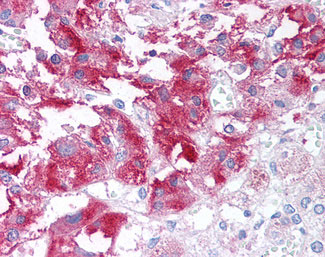USP20 / VDU2 Antibody (Internal)
Rabbit Polyclonal Antibody
- SPECIFICATION
- CITATIONS
- PROTOCOLS
- BACKGROUND

Application
| IHC-P |
|---|---|
| Primary Accession | Q9Y2K6 |
| Reactivity | Human, Monkey |
| Host | Rabbit |
| Clonality | Polyclonal |
| Calculated MW | 102kDa |
| Dilution | IHC-P (10 µg/ml) |
| Gene ID | 10868 |
|---|---|
| Other Names | Ubiquitin carboxyl-terminal hydrolase 20, 3.4.19.12, Deubiquitinating enzyme 20, Ubiquitin thioesterase 20, Ubiquitin-specific-processing protease 20, VHL-interacting deubiquitinating enzyme 2, hVDU2, USP20, KIAA1003, LSFR3A, VDU2 |
| Target/Specificity | Human USP20. BLAST analysis of the peptide immunogen showed no homology with other human proteins. |
| Reconstitution & Storage | Long term: -70°C; Short term: +4°C |
| Precautions | USP20 / VDU2 Antibody (Internal) is for research use only and not for use in diagnostic or therapeutic procedures. |
| Name | USP20 |
|---|---|
| Synonyms | KIAA1003, LSFR3A, VDU2 |
| Function | Deubiquitinating enzyme that plays a role in many cellular processes including autophagy, cellular antiviral response or membrane protein biogenesis (PubMed:27801882, PubMed:29487085). Attenuates TLR4- mediated NF-kappa-B signaling by cooperating with beta-arrestin-2/ARRB2 and inhibiting TRAF6 autoubiquitination (PubMed:26839314). Promotes cellular antiviral responses by deconjugating 'Lys-33' and 'Lys-48'- linked ubiquitination of STING1 leading to its stabilization (PubMed:27801882). Plays an essential role in autophagy induction by regulating the ULK1 stability through deubiquitination of ULK1 (PubMed:29487085). Acts as a positive regulator for NF-kappa-B activation by TNF-alpha through deubiquitinating 'Lys-48'-linked polyubiquitination of SQSTM1, leading to its increased stability (PubMed:32354117). Acts as a regulator of G-protein coupled receptor (GPCR) signaling by mediating the deubiquitination beta-2 adrenergic receptor (ADRB2) (PubMed:19424180). Plays a central role in ADRB2 recycling and resensitization after prolonged agonist stimulation by constitutively binding ADRB2, mediating deubiquitination of ADRB2 and inhibiting lysosomal trafficking of ADRB2. Upon dissociation, it is probably transferred to the translocated beta-arrestins, possibly leading to beta-arrestins deubiquitination and disengagement from ADRB2 (PubMed:19424180). This suggests the existence of a dynamic exchange between the ADRB2 and beta-arrestins. Deubiquitinates DIO2, thereby regulating thyroid hormone regulation. Deubiquitinates HIF1A, leading to stabilize HIF1A and enhance HIF1A-mediated activity (PubMed:15776016). Deubiquitinates MCL1, a pivotal member of the anti- apoptotic Bcl-2 protein family to regulate its stability (PubMed:35063767). Within the endoplasmic reticulum, participates with USP33 in the rescue of post-translationally targeted membrane proteins that are inappropriately ubiquitinated by the cytosolic protein quality control in the cytosol (PubMed:33792613). |
| Cellular Location | Cytoplasm {ECO:0000250|UniProtKB:Q8C6M1}. Endoplasmic reticulum. Cytoplasm, perinuclear region. Cytoplasm, cytoskeleton, microtubule organizing center, centrosome |
| Volume | 50 µl |

Thousands of laboratories across the world have published research that depended on the performance of antibodies from Abcepta to advance their research. Check out links to articles that cite our products in major peer-reviewed journals, organized by research category.
info@abcepta.com, and receive a free "I Love Antibodies" mug.
Provided below are standard protocols that you may find useful for product applications.
Background
Deubiquitinating enzyme involved in beta-2 adrenergic receptor (ADRB2) recycling. Acts as a regulator of G-protein coupled receptor (GPCR) signaling by mediating the deubiquitination beta-2 adrenergic receptor (ADRB2). Plays a central role in ADRB2 recycling and resensitization after prolonged agonist stimulation by constitutively binding ADRB2, mediating deubiquitination of ADRB2 and inhibiting lysosomal trafficking of ADRB2. Upon dissociation, it is probably transferred to the translocated beta-arrestins, possibly leading to beta-arrestins deubiquitination and disengagement from ADRB2. This suggests the existence of a dynamic exchange between the ADRB2 and beta-arrestins. Deubiquitinates DIO2, thereby regulating thyroid hormone regulation. Deubiquitinates HIF1A, leading to stabilize HIF1A and enhance HIF1A-mediated activity. Mediates deubiquitination of both 'Lys-48'- and 'Lys-63'-linked polyubiquitin chains.
References
Li Z.,et al.Biochem. Biophys. Res. Commun. 294:700-709(2002).
Nagase T.,et al.DNA Res. 6:63-70(1999).
Humphray S.J.,et al.Nature 429:369-374(2004).
Mural R.J.,et al.Submitted (JUL-2005) to the EMBL/GenBank/DDBJ databases.
Gilley J.,et al.Hum. Mol. Genet. 8:1313-1320(1999).
If you have used an Abcepta product and would like to share how it has performed, please click on the "Submit Review" button and provide the requested information. Our staff will examine and post your review and contact you if needed.
If you have any additional inquiries please email technical services at tech@abcepta.com.













 Foundational characteristics of cancer include proliferation, angiogenesis, migration, evasion of apoptosis, and cellular immortality. Find key markers for these cellular processes and antibodies to detect them.
Foundational characteristics of cancer include proliferation, angiogenesis, migration, evasion of apoptosis, and cellular immortality. Find key markers for these cellular processes and antibodies to detect them. The SUMOplot™ Analysis Program predicts and scores sumoylation sites in your protein. SUMOylation is a post-translational modification involved in various cellular processes, such as nuclear-cytosolic transport, transcriptional regulation, apoptosis, protein stability, response to stress, and progression through the cell cycle.
The SUMOplot™ Analysis Program predicts and scores sumoylation sites in your protein. SUMOylation is a post-translational modification involved in various cellular processes, such as nuclear-cytosolic transport, transcriptional regulation, apoptosis, protein stability, response to stress, and progression through the cell cycle. The Autophagy Receptor Motif Plotter predicts and scores autophagy receptor binding sites in your protein. Identifying proteins connected to this pathway is critical to understanding the role of autophagy in physiological as well as pathological processes such as development, differentiation, neurodegenerative diseases, stress, infection, and cancer.
The Autophagy Receptor Motif Plotter predicts and scores autophagy receptor binding sites in your protein. Identifying proteins connected to this pathway is critical to understanding the role of autophagy in physiological as well as pathological processes such as development, differentiation, neurodegenerative diseases, stress, infection, and cancer.


